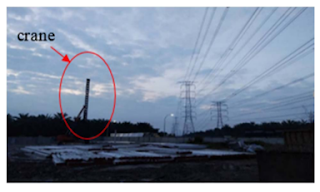Transmission line faults can arise due to various reasons, and they can be categorized into several causes:
1. Weather Conditions - Adverse weather conditions like lightning, heavy storms, strong winds, ice, or snow can cause faults by physically damaging the transmission lines or creating conditions conducive to electrical faults.
2. Equipment Failure - Malfunction or failure of components such as insulators, conductors, transformers, switches, etc can lead to faults along the transmission line.
Transformer insulation breakdown
3. Human Error - Mistakes made during maintenance, repair, or operational procedures can result in faults. Accidental contact with equipment or improper handling of the infrastructure can cause disruptions.
Crane encroachment [1]
4. Vegetation Interference - Trees or vegetation growing too close to the transmission lines can create faults when branches or the foliage come into contact with the lines, especially during adverse weather conditions.
5. Animal Interference - Animals, especially birds or small mammals, can inadvertently cause faults by coming into contact with transmission lines or equipment.
Bird nest
6. Corrosion or Aging - Over time, corrosion or aging of the equipment or infrastructure can weaken its structural integrity, leading to faults.
Degraded insulator [1]
7. Lightning Strikes - Lightning can directly strike transmission lines or nearby structures, causing immediate faults or damage due to the high voltage surges it generates.
8. Overloading or Overvoltage - Excessive loads or sudden surges in voltage can stress the transmission lines beyond their capacity, leading to faults.
9. Ground Faults - When a conductor comes into contact with the ground or another conductor, it can create a fault due to an unintended path for the electrical current.
Identifying and resolving these faults promptly is crucial to maintaining the reliability and safety of the transmission system. Techniques like regular inspections, using advanced monitoring systems, and employing protective devices help in minimizing faults and ensuring a reliable transmission network.
Image Reference
[1] S.H. Asman, N.F. Ab Aziz, M.Z.A. Abd Kadir, U.A.U. Amirulddin, Fault Signature Analysis Based on Digital Fault Recorder in Malaysia Overhead Line System.






No comments:
Post a Comment